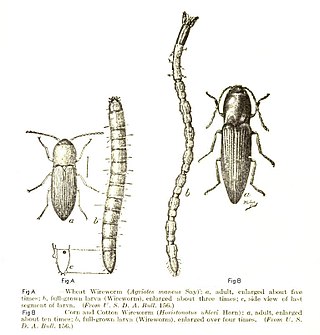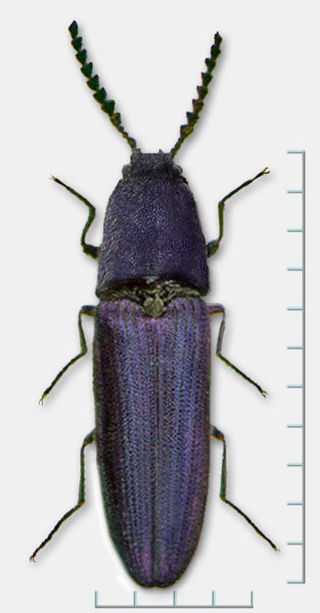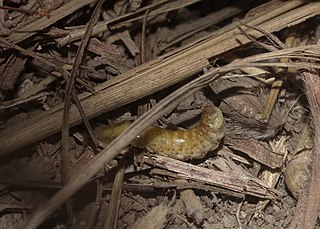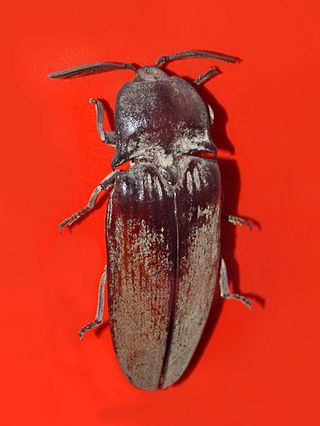
Beetles are insects that form the order Coleoptera, in the superorder Holometabola. Their front pair of wings are hardened into wing-cases, elytra, distinguishing them from most other insects. The Coleoptera, with about 400,000 described species, is the largest of all orders, constituting almost 40% of described insects and 25% of all known animal species; new species are discovered frequently, with estimates suggesting that there are between 0.9 and 2.1 million total species. Found in almost every habitat except the sea and the polar regions, they interact with their ecosystems in several ways: beetles often feed on plants and fungi, break down animal and plant debris, and eat other invertebrates. Some species are serious agricultural pests, such as the Colorado potato beetle, while others such as Coccinellidae eat aphids, scale insects, thrips, and other plant-sucking insects that damage crops. Some others also have unusual characteristics, such as fireflies, which use a light-emitting organ for mating and communication purposes.

Elateridae or click beetles are a family of beetles. Other names include elaters, snapping beetles, spring beetles or skipjacks. This family was defined by William Elford Leach (1790–1836) in 1815. They are a cosmopolitan beetle family characterized by the unusual click mechanism they possess. There are a few other families of Elateroidea in which a few members have the same mechanism, but most elaterid subfamilies can click. A spine on the prosternum can be snapped into a corresponding notch on the mesosternum, producing a violent "click" that can bounce the beetle into the air. Clicking is mainly used to avoid predation, although it is also useful when the beetle is on its back and needs to right itself. There are about 9300 known species worldwide, and 965 valid species in North America.

Polyphaga is the largest and most diverse suborder of beetles. It comprises 144 families in 16 superfamilies, and displays an enormous variety of specialization and adaptation, with over 350,000 described species, or approximately 90% of the beetle species discovered thus far.

Elateriformia is an infraorder of polyphagan beetles. The two largest families in this group are buprestids, of which there are around 15,000 described species, and click beetles, of which there are around 10,000 described species.

The violet click beetle is a black beetle, 12 mm (0.5 in) long, with a faint blue/violet reflection. It gets its name from the family habit of springing upwards with an audible click if it falls on its back. It occurs in Europe.

The Elateroidea are a large superfamily of beetles. It contains the familiar click beetles, fireflies, and soldier beetles and their relatives. It consists of about 25,000 species.

Camillo Rondani was an Italian entomologist noted for his studies of Diptera.

The Rhagophthalmidae are a family of beetles within the superfamily Elateroidea. Members of this beetle family have bioluminescent organs on the larvae, and sometimes adults, and are closely related to the Phengodidae, though historically they have been often treated as a subfamily of Lampyridae, or as related to that family. Some recent evidence suggested that they were the sister group to the Phengodidae, and somewhat distantly related to Lampyridae, whose sister taxon was Cantharidae, but more reliable genome-based phylogenetics placed as the sister group to the Lampyridae.
Qongqothwane is a traditional song of the Xhosa people of South Africa. It is sung at weddings to bring good fortune. In the western world it is mainly known as The Click Song. The Xhosa title literally means "knock-knock beetle", which is a popular name for various species of darkling beetles that make a distinctive knocking sound by tapping their abdomens on the ground. These beetles are believed by the Xhosa to bring good luck and rain.

Ptinidae is a family of beetles in the superfamily Bostrichoidea. There are at least 220 genera and 2,200 described species in Ptinidae worldwide. The family includes spider beetles and deathwatch beetles.

Bionicle: The Legend Reborn is a 2009 animated science fantasy action film based on the Bionicle toy line by Lego. It is the fourth and final Bionicle film to be released. Distributed by Universal Studios Home Entertainment, the film is a stand-alone sequel to the trilogy of films released by Buena Vista Home Entertainment under the Miramax Home Entertainment label. It follows the toy line's 2009 story and features a different set of characters than that of the first three films. The Legend Reborn was released on September 15, 2009, in the United States and Canada, October 5 in the United Kingdom, and September 2 in Australia. The film stars Michael Dorn as the voice of Mata Nui.

Alaus oculatus, commonly called the eastern eyed click beetle or eyed elater, is a species of click beetle.
Dixton Wood is a 13.14-hectare (32.5-acre) biological Site of Special Scientific Interest in Gloucestershire, notified in 2000. Dixton Wood is recognised as a Special Area of Conservation (SAC) under the EU Habitats Directive.

Eucnemidae, or false click beetles, are a family of elateroid beetles including about 1700 species distributed worldwide.

Tetralobus flabellicornis, the Giant Acacia Click Beetle, is a species of click beetle belonging to the family Elateridae.

Throscidae is a family of elateroid beetles found worldwide with around 150 species in 5 extant genera. The larvae are soil-dwelling, siphoning fluid from mycorrhizae attached to trees. The adults are short-lived, with the adult males being noted for a complex mating dance. Like some other elateroids, they are capable of clicking.

Sinopyrophorus is a genus of bioluminescent hard-bodied clicking beetles in the superfamily Elateroidea, and is the sole member of the recently recognized family Sinopyrophoridae. The genus currently contains a single species, Sinopyrophorus schimmeli, which was described in 2019 from the subtropical evergreen broadleaf forests of western Yunnan, China.

Oxynopterus mucronatus, sometimes known as the giant click beetle, is a species of click beetle from tropical Southeast Asia. Their larvae are specialized predators of termites.
Giant click beetle can refer to several large members of the family Elateridae, including:
















